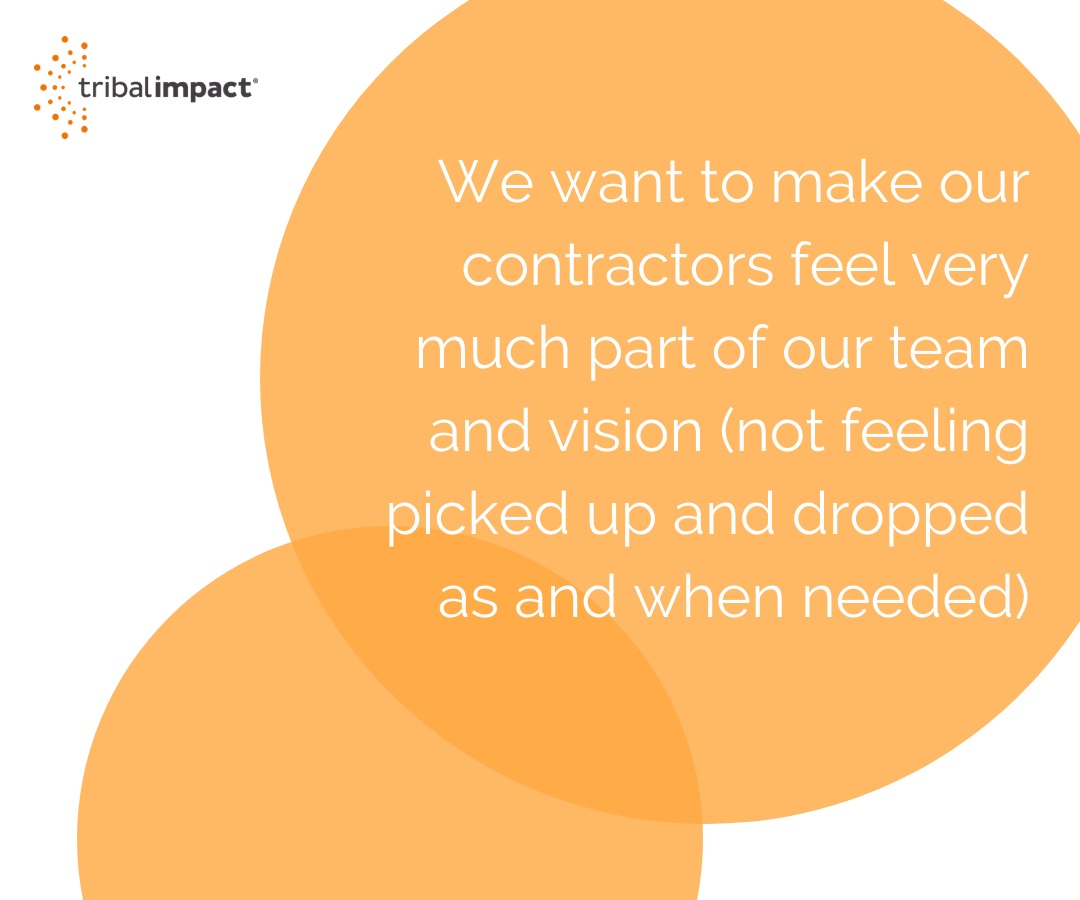Felipe shares his personal journey on onboarding our Extended Tribe and why providing them with extra value is key to all our success. Key takeaways that can apply to any business looking to attract or retain talent.

Some of us at Tribal Impact work in the sun (like me in Barcelona), some in far-off lands like Bali and others in rainy (but vibrant) Manchester.
Some of us are part of what we call our “Core Tribe” of employees and others fall into our “Extended Tribe”. They’re contractors, but they’re still a part of the tribe (and our success) just as much as anyone else.
So we want to make our contractors feel very much part of our team and vision (not feeling picked up and dropped as and when needed). That’s why our Tribal Leader, Sarah, recently tasked me with onboarding our contractors to help achieve this.
You may wonder where I’m going with this. But when I started this process, I quickly realised that there are a lot of similarities in onboarding new clients and our contractors.
We need to add value, delight and partner with them. So today I’m sharing my journey the key takeaways applicable for any business looking to attract and retain talent.
1. Reviewing The Scope Of Work & Identifying Skillsets
With the summer holiday season approaching, we knew that a quiet time was on its way, so I made sure that we maximised this time. I started by creating a skills matrix for our contractors, assessing who was best suited to certain projects.
But I also asked our contractors what projects they liked and disliked and whether there were any areas they’d like to develop further (or even try out). Our thinking behind this was simple: it could help us scale but also benefit our contractors’ careers.
The key takeaway: Use business downtimes to upskill your team. It not only helps you scale, it enhances their overall career prospects, engagement and loyalty.
2. Understanding How Our Contractors Operate
We all work remotely at Tribal Impact, with may of doing so for the work-life balance, so it can be a difficult task to make sure we collaborate effectively.
So I asked them:
- Do they have a business or are they working on a freelance basis?
- When do they carry out the work? e.g. Is it in the evening to fit around childcare?
- When’s the best time for them to take calls ?
- Do they have the capacity to take on more work?
- How do they best communicate? Is it via email? Or would they prefer sending a message via Microsoft Teams.
And I had to look at ways of matching the best times with everyone else on the team.
The key takeaway: It's even difficult to balance time when in the office but doing so leads to better productivity (and happiness) outcomes for everyone.
3. Reviewing Whether They Have The right Tools
Project-led teams all face the same difficulty of seeing where everyone else is up to and if they're on track. So we decided to provide our contractors with access to our project management tool Asana.
It wasn’t as easy as implementing a tool and running with it as I had to consider all the variables and set up clear procedures and checklists. But it’s paid off. We’ve improved both ours and our contractors’ efficiencies (and stress levels!).
Key takeaway: The better equipped people are to carry out their projects faster, without compromising on quality, the better for all. Use quiet periods to plan the tool’s implementation effectively.
4. Establish A Personal Connection By Delighting Them
A big part of building a relationship with our clients is the small (but important) things we do that show we genuinely want to get to know and help them, such as:
- Having regular calls
- Offering different types of communication
- Sending them useful information
- Helping them develop professionally (and in turn, look good)
So we do this for customers. And now we also do this for contractors.
I looked at their skills gaps and planned training sessions over the summer period. Our contractors are now also part of our Microsoft Exchange, where we share valuable resources and news on what’s happening at Tribal. That way, we were helping them learn whilst also making them feel part of our tribe.
Key takeaway: Everyone wants to look good to their directors, boss or clients. So help educate them and bring something new that helps them innovate. That’s the key thing.
5. If It Works, It’s Obsolete: Working In Partnership For Better Outcomes
Working with clients and our contractors means I’ve been challenged to learn from both sides.
It means: Okay, what can we do now? What's next? How can we improve it? How can we fix it? How can we get better results? How do we help overcome people’s fear of being a fraud when trying new things?
I’ve learned a lot about how we instil this as part of our DNA during our onboarding project, but it’s something I’ll touch on more in part two of this post.
For now, I’m delighted to say that we must have done something right. And I think that’s shown in the turnout we got at our recent Tribal meeting. We had all of our Core Tribe and many of our Extended Tribe altogether in one room. And we had an amazing time learning and chatting in person!


